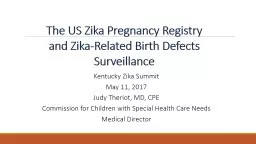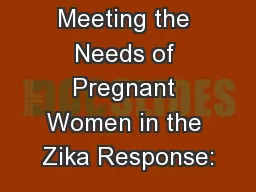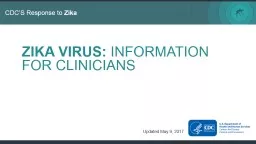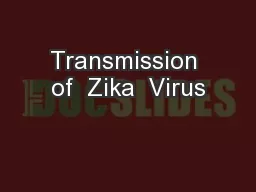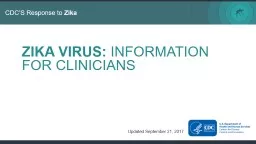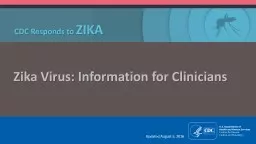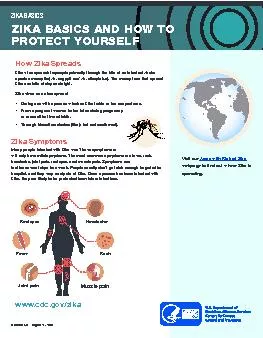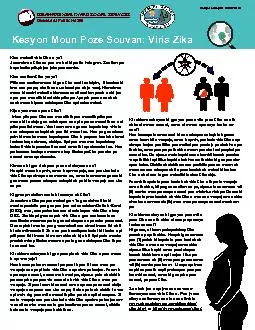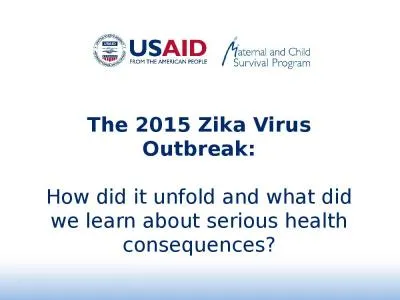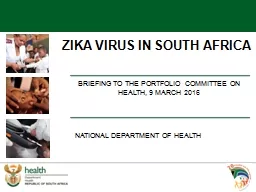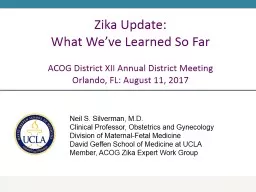PPT-The US Zika Pregnancy Registry and
Author : Outlawking | Published Date : 2022-08-03
Zika Related Birth Defects Surveillance Kentucky Zika Summit May 11 2017 Judy Theriot MD CPE Commission for Children with Special Health Care Needs Medical Director
Presentation Embed Code
Download Presentation
Download Presentation The PPT/PDF document "The US Zika Pregnancy Registry and" is the property of its rightful owner. Permission is granted to download and print the materials on this website for personal, non-commercial use only, and to display it on your personal computer provided you do not modify the materials and that you retain all copyright notices contained in the materials. By downloading content from our website, you accept the terms of this agreement.
The US Zika Pregnancy Registry and: Transcript
Zika Related Birth Defects Surveillance Kentucky Zika Summit May 11 2017 Judy Theriot MD CPE Commission for Children with Special Health Care Needs Medical Director Objectives Describe the US Zika Pregnancy Registry USZPR. Updated . November 18, . 2016. Introduction. Zika virus is spread to people primarily through the bite of an infected . Aedes . species mosquito (. Ae. aegypti . and . Ae. albopictus. ). . Many . people infected with Zika virus won’t have symptoms or will only have mild . PlatformQHealth. Joanne Cono, MD, ScM. Director. Office of Science Quality. Office of the Director. Centers for Disease Control and Prevention. April 6, 2016. Zika Virus Overview. 2. Zika Virus. Single stranded RNA Virus. Testing and Using a Live Vaccine in Pregnancy?. Carleigh Krubiner, PhD. Johns Hopkins Berman Institute of Bioethics. Global Forum on Bioethics in Research. Buenos Aires, Argentina. November 3, 2016. Funded. Updated May 9, 2017. Zika virus epidemiology. Diagnoses and testing. Case reporting. Zika and pregnancy. Clinical management of infants. Sexual transmission. Preconception guidance. Infection control. June 15, 2016. Dr. Howard Haft, Deputy Secretary for Public Health, DHMH. Robin Waddell, Deputy Health Officer – Operations, Cecil County Health Department. Fred von Staden, Director, Environmental Health Services, Cecil County Health Department. Cassandra Salgado, MD, MS, FIDSA, FSHEA. Professor of Medicine and Public Health. Division Director, Infectious Diseases. Medical University of South Carolina. Active . Zika. Virus Transmission June 2016. FOR CLINICIANS. Updated September 21, . 2017. Zika virus epidemiology. Diagnoses and testing. Case reporting. Zika and pregnancy. Clinical management of . infants. Sexual . transmission. Preconception . . Information for Clinicians. Updated . August 5, . 2016. This training provides clinicians with information . about. Zika virus epidemiology. Diagnoses and testing. Case reporting. Zika and pregnancy. Introducción. El virus del Zika se propaga entre las personas, principalmente a través de la picadura de un mosquito infectado de la especie . Aedes . (. Ae. .. aegypti. y . Ae. .. albopictus. ). . www.cdc.gov/zika How Zika Spreads Zika virus spreads to people primarily through the bite of an infected Aedes species mosquito ( Ae. aegypti and Ae. albopictus ). The mosquitoes that spread Zika ca Jeneralman Zika se yon maladi ki pa n twò grav. Sentòm yo kapab dire plizyè jou jiska yon semèn. Kisa sentòm Zika yo ye? Pifò nan sentòm moun ki gen Zika santi se lafyèv, ti bouton ki How did it unfold and what did we learn about serious . health consequences?. Evidence on Zika virus infection and its consequences has . continued to evolve. Please consult the WHO, PAHO, and U.S. . BRIEFING TO THE PORTFOLIO COMMITTEE ON HEALTH, 9 MARCH 2016. NATIONAL DEPARTMENT OF HEALTH. Outline. Background to Zika virus. First case of Zika virus in South Africa. Public health implications. Actions taken. ACOG District XII Annual District Meeting. Orlando, FL: August 11, 2017. Neil S. Silverman, M.D.. Clinical Professor, Obstetrics and Gynecology. Division of Maternal-Fetal Medicine. David Geffen School of Medicine at UCLA.
Download Document
Here is the link to download the presentation.
"The US Zika Pregnancy Registry and"The content belongs to its owner. You may download and print it for personal use, without modification, and keep all copyright notices. By downloading, you agree to these terms.
Related Documents

